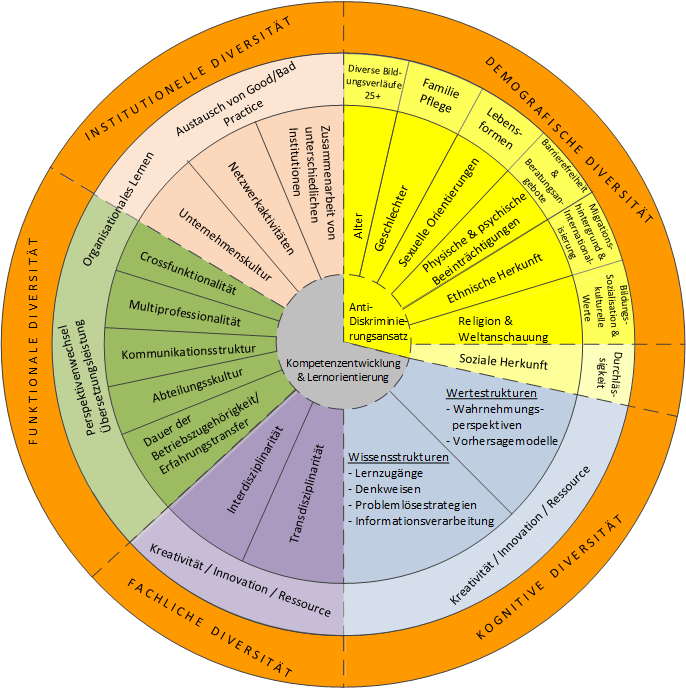Diversity-Conscious Teaching
Diversity and its appreciation are an essential part of the university's self-image and thus also of the teaching and learning culture at the TH Köln. We accompany you on your way to a more diversity-conscious teaching and working environment.

In a nutshell: What Is Diversity?
Diversity means variety or multiplicity. It is anchored as a cross-cutting theme in the individual university departments and, accordingly, is also part of the teaching and learning culture (German) at TH Köln. TH Köln promotes an inclusive university culture and creates a diversity-conscious working environment to enable as many people as possible to participate in teaching and learning at the university.
Basics: Diversity-Conscious Teaching
In order to teach with diversity in mind, you as teachers should already be conscious of how diverse the students and all those involved are when designing teaching and learning environments. You have a decisive role to play as experts in your respective subjects, as learning facilitators and mentors. You support your students and always view their performance in the context of their own lives in order to recognize potential and promote individual talent. Your open-minded approach is reflected in the concept, execution and development of your teaching.
The behaviour of teachers is decisive in determining who is included and who is excluded.
Frank Linde, Professor für Wirtschaftswissenschaften, Fakultät für Informations- und
Kommunikationswissenschaften
The video (German) shows you the possible ways in which diversity can be addressed in higher education teaching.
Reflecting Diversity when Teaching
Teaching with diversity in mind also means reflecting on diversity in the context of higher education—in other words, taking all levels into account. The aim of colleges is to level the playing field and promote diversity as an enhancement to the educational process. Therefore, it is helpful to reflect on which aspects of diversity have a role to play in …
… the university,
… your own faculty,
… or in your specific course.
To answer these questions, the so-called HEAD Wheel (short for Higher Education Awareness for Diversity) was developed, which addresses five different diversity sectors of higher education: demographic, cognitive, disciplinary, functional, and institutional.

It is impossible to say in general terms when which form of diversity is relevant. This question must be asked again and again in different contexts and situations. This means, if necessary, drawing consequences for one’s own actions and offering integrative measures, or indeed adapting one’s teaching and teaching arrangements.
Useful Tip
Gehen Sie die verschiedenen Dimensionen des HEAD Wheels durch und überlegen Sie, wo Ihnen überall verschiedene Formen der Diversität begegnen.
Diversity in Digital Settings
Digital teaching encompasses many different scenarios and settings. However, teaching digitally with diversity in mind does not simply mean using a variety of methods, but rather using methods adapted to discussion groups. These can be designed in very different ways, but there are some aspects that should always be taken into account in diversity-oriented digital teaching, including:
- gender-inclusive language / diversity-sensitive media language (German)
- shaping and appreciating a culture of discussion and communication
- creating different (technical) possibilities for participation.
You can also support your students by allowing for individual ways to achieve learning objectives, possibly through a variety of approaches, resources, or even exams. You can also use digital tools to assess needs and gather feedback.
Useful Tip
Prüfen Sie zunächst, welches Ziel Ihr (digitales) Modul hat. Überlegen Sie, wen Sie vor sich haben, wer Ihre Studierenden sind und wie Sie diese passend hin zum Lernergebnis begleiten. Gehen Sie nicht von der Methode aus, sondern von Ihren Studierenden und dem angestrebten Lernerfolg. Berücksichtigen Sie die Besonderheiten von Diversität in digitalen und hybriden Settings.
Any questions?
Feel free to contact us by mail to lehrpfade@th-koeln.de!
Good Practices
Diversität an anderen Hochschulen
Diversität in der digitalen Lehre
- Ansprache von Studierenden: Richtiges „Gendern“ in der digitalen Kommunikation (Beitrag der FU Berlin)
- Handlungsempfehlungen für eine diversitätssensible Mediensprache (Beitrag der Universität Frankfurt)
- Gender- & Diversitätsreflexivität in der digitalen Lehre (Beitrag des Hochschulforums Digitalisierung)
- Gender- und Diversitykompetenz für die digitale Lehre (Beitrag der FU Berlin)
- Gender Mainstreaming und Diversity im E-Learning (Beitrag auf e-teaching.org)
Diversität-Checklisten
Links & Literature
- KomDiM im Zentrum für Kompetenzentwicklung für Diversity Management
- Diversität in der Hochschullehre – Didaktik für den Lehralltag. Linde, F. & Auferkorte-Michaelis, N. (2021) (aus dem Hochschulnetz der TH Köln online verfügbar)
- Auf mehreren Ebenen agieren. Diversitätsorientierte Hochschullehre. Linde, F. & Auferkorte-Michaelis, N. (2018)
- Das Diversity Wheel der FH OÖ. Gaisch, M. & Aichinger, R. (2016)
Header-Bild: © tirachard/stock.adobe.com



